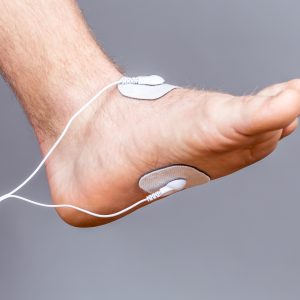
Foot/Ankle Pain
Conditions that may be treated:
- Arthritis of the foot or ankle (also called degenerative joint disease or osteoarthritis) This usually affects the toes
- Rheumatoid arthritis affecting the foot and ankle, especially the toes
- Tendinitis of one or more of the tendons within the foot or ankle
- Tarsal tunnel syndrome
- Dancers foot and toe problems
- Runners foot and ankle problems
- Ankle sprain
- Achilles tendon strain or partial tear
Basic Treatment
- Refer to the reference photo for basic options of foot and ankle pain placement of electrodes. Note: when placing electrodes around a joint, notice that we try to have them on opposite sides so that the current passes between the two electrodes and through the joint.
- Clean the skin with a wet paper towel and water to remove dead skin and other surface debris
- Do not have any lotion on the skin as it may decrease conductivity and/or create a skin irritation
- Apply the electrodes as instructed in the basic treatment procedure to area of pain using the photos noted for placement suggestions
- Turn unit on and move the cursor to the general area that you want to treat
- Press the start button and the unit does all the work. It will go through 2 phases of different currents during the total time.
Damage to the ligaments of the ankle from overstretching or trauma.
Possible treatment:
- If the injury is less than 48 hours old, always use an application of ice in some form, such as an ice pack, frozen vegetable bag, baggie with ice. Ice should always have a layer of toweling between the pack and the skin to prevent tissue damage from cold. 15-20 minutes prior Following 48 hours heat may be used. Many people continue with the ice for ankle sprains as it numbs the area.
- Apply the PAT unit on the foot/ankle setting and keep the intensity on 2-3 for the duration of the treatment
- Elevation of the leg is important at least at the level of a reclined footrest to reduce swelling.
- You should remain off of your acutely sprained ankle and use crutches or a walker to take the weight off during walking. You will only damage the joint further if you walk on it too soon.
This may be from arthritis or an old injury such as an old ankle sprain which has healed but still painful.
- Typically heat feels the best although ice/cold pack may be used according to your personal preference.
- Apply the PAT unit on the foot/ankle area and use at the pre-setting on the unit. It will treat automatically through both phases for maximal relief.
- NOTE: any chronic joint may have an accumulation of waste material from the metabolism going on in the tissue. When there is a restriction of movement or chronic swelling these waste products accumulate. When the treatment normalizes the tissue, it releases these waste products into the surrounding tissue which can cause temporary pain and even nausea if there is a lot a waste material released. This is typically a one time occurrence and should be considered a positive result of the treatment.
- Note: in chronic ankle conditions it is often the case that the joint is so constricted that it does move properly. In order for the ankle to flex forward and back it has to have joint mobility within the two bones that make up the ankle, that is the tibia and fibula. If you have chronic ankle pain and are unable to flex your foot up past the right angle. That is the foot should flex upward past 90 degrees to about 15-20 degrees. If this is the case, the ankle may need manual physical therapy. You should find a private practice PT who specializes in manual therapy so that they can help you restore the motion. Otherwise, the pain may never go away.
Case History
- CB, North Carolina – 23 y/o male injured during soccer contest. After three months the injury persisted. Used device and pain was relieved and the injury was no longer an issue within a week of treatments. Changed nothing else, but added the device. Credits device with regaining pre-injury health.
